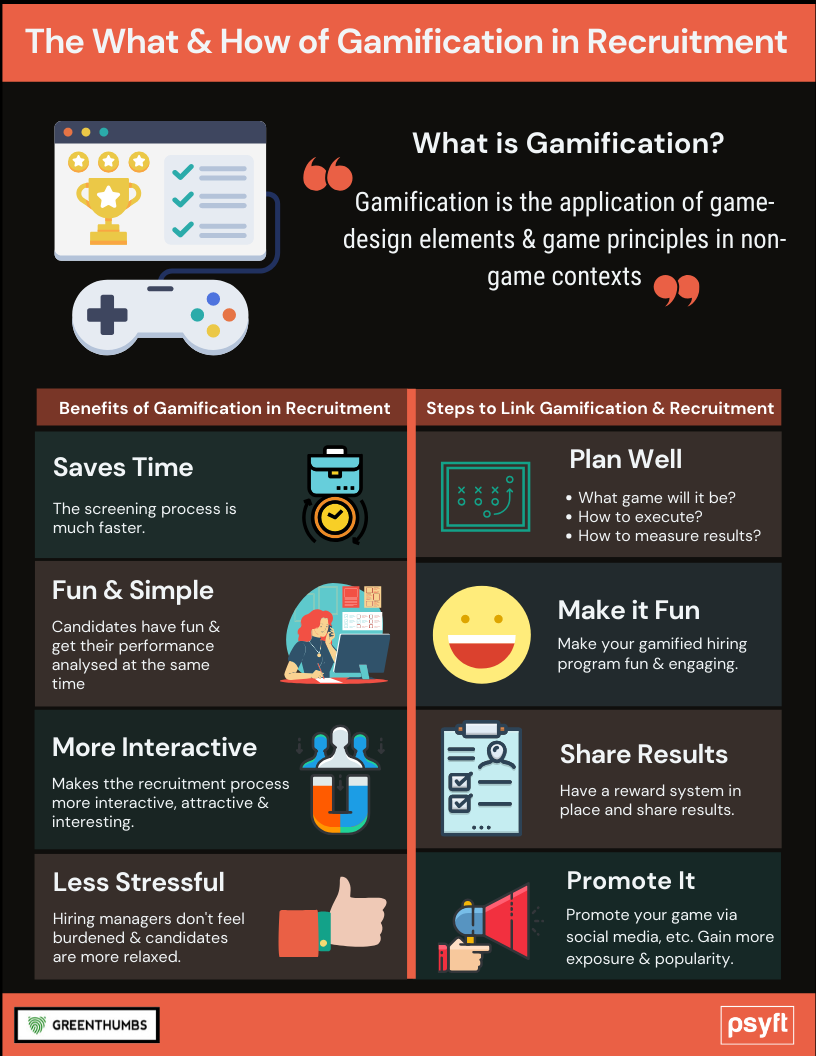Blogs
Your source to the latest insights on what's trending in the HR arena - Recruitment, Talent Assessments, Employee Surveys and Training.

The What and How of Gamification in Recruitment?
Gamification is receiving a lot of attention in both business and education. According to Fortune magazine companies are realizing that gamification is an effective way to boost business. Games are one of the most powerful motivators. Companies are leveraging gamification as a strategy to engage consumers and clients, for promotion, marketing, etc. Over 350 companies have launched major gamification programs since 2010.
Gamification is also proving its worth in the Human Resource Industry. As employee retention and engagement continue to remain the biggest challenges, gamification seems to be a remedy to motivate employees, and keep them happy.
What is Gamification?
The term Gamification was coined by Nick Pelling in 2002, however, it wasn’t until late 2010 that the term came to gain widespread popularity. As the term suggests, gamification is about transferring some of the positive characteristics of a game to something that is not a game, hence, gami-“fy”-ing. Gamification is about testing an individual’s behavior, analytical and logical ability through different types of tasks.
Gamification popularity has also witnessed a hike because of –
(1) Rapid increase in the use of smartphones
(2) Tremendous growth of mobile internet
(3) Increased use of social media
Gamification in Recruitments
The traditional job interviews have turned mundane and monotonous. Candidates generally have an idea about what are they going to be asked and have usually prepared scripted answers that don’t help much to identify if they are the right fit for the job.
Google organizes a Google Code Jam software-writing competition (it’s been there for over 12 years now) as a way to find fresh, new talent to work for the company.
Marriott International, the hotel chain, is a great example of how to use social media to promote their employer brand through an application on its Facebook page like “Farmville” and the “Sims”.
Sodexo – A food and service company, has created the “Que-Social” platform. This Platform is used to attract new talent using game mechanics.
These are just a few examples from a vast pool of companies you which are adopting the mechanics of gamification to up the ante in recruitment.
A hiring manager will always look to better understand a candidate’s experience, behavior, temperament, sentiment, confidence, and finally assess if they will be a good fit for the role as well as the organization. Gamification when applied to the recruitment process, can yield some major benefits.
• It’s Quick, saves time - The elimination process is much faster as companies can test specific skill-sets of candidates, such as problem solving, innovative thinking, creativity etc. through simulated scenarios/themes, in one go and filter candidates accordingly.
• It’s fun and Simple - Gamification is generally very interesting. Candidate can easily come aboard, use their skills while playing and have fun at the same time.
• It’s more Interactive - Gamification is a smart and attractive way of interviewing and screening potential hires. It makes recruitment more interactive and also adds up to the brand value of an organisations, especially among the vibrant & dynamic generation Z and millennial talent.
• It’s Less Stressful - Gamified hiring is less stressful both for the hiring managers and job applicants. Since it’s quick, fun, easy hiring managers do not feel burdened with the whole screening and selection. At the same time, and candidates feel way more relaxed during the hiring process.
How to introduce gamification to your recruitment process?
Steps that’ll help you incorporate gamification in your recruitment process.
Step 1: Plan wellThere’s always a level of risk involved when we talk about new technology is. Organizations have to plan this process extremely well and analyze the way it’s going to be introduced. Set precise goals, so you’ll know what you can achieve when you go the Gamifying way. Organizations need to be asked -
• What type of game will this be?
• How is it going to help test relevant skills and knowledge?
• How will you measure the results?
• How will you execute?
The core reason behind gamifying something is to boost interest and engagement. Organisations must ensure that the program they launch must be fun and creative and doesn’t make candidates feel like they are being monitored. The game should be simple, entertaining, and highly interactive. So don’t try to turn it into some type of test that asks the candidates to choose from multiple options to questions, etc. that’s not a game. Some ways in which organizations can link gamification to recruitment could include - Leaderboards/ dashboards, Employee referrals, puzzles, etc.
Step 3: Share ResultsWaiting too long for results will make applicants lose interest. The best part about games is that they give you results instantly. You must have some kind of reward system in place that informs the candidates how they have performed.
Step 4: Promote The GameWhen a company introduces gamification in the recruitment process, it gains a chance to prove how is it better than its competitors. It is important to promote your gamified recruitment program through social media, etc. so that it reaches out to more people and gains more exposure and popularity.
There’s also a Flipside
Can gamification be fully incorporated into the formal recruitment program? A few reasons why using gamification might not be not very practical always:
• The Seriousness Needs to be SustainedIt’s important to keep in mind that while gamifying the hiring process, companies need to make candidates understand that it’s still a proper screening procedure and has to be taken in all seriousness even though there’s a fun element involved. Gamification in recruitment aims at making the whole application experience easy, smooth, interesting and engaging for candidates, however, it’s still about shortlisting candidates based on their performance, that’ll land them up with a job in the end.
• One Size Will Not Fit AllWith all the advantages and fun elements, what has to be realized is that the formal procedure where candidates complete a standard application and participate in a typical interview process might still be the way for many organizations. Therefore, it’s important to realize what will work for your company best.
• Gamification Requires Major InvestmentDifferent roles will require different gaming applications, different stages, different reward mechanisms, etc. Building all this is not going to be easy; it requires extensive web development techniques. Your development team would need to plan the game, build it, and figure out how to integrate it into your hiring process. On top of this, the cost will have a major role to play.
Conclusion
Implementing gamification in the recruitment and selection process can be entertaining for the hiring personnel, the candidates, as well as the organization as a whole. Gamification has gained ground in recruitments. Progressive companies can use interactive games to boost hiring, promote employee engagement, employee development and training. What organizations need to be wary of is if gamification is the best talent search strategy they should adopt to attract and hire people.
FAQs
1 : What is gamification, and why is it gaining attention in various industries?
Answer : Gamification is the application of game elements and principles to non-game contexts, such as business and education. It is gaining attention because it has proven to be an effective way to engage and motivate individuals, including employees, customers, and clients.
2 : How is gamification being used in the Human Resource industry, specifically in recruitment?
Answer : Gamification is being used in HR, especially in recruitment, to make the hiring process more engaging and interactive. It allows companies to assess candidates' skills and behaviors through game-like scenarios, making the process quicker and more enjoyable.
3 : What are the benefits of incorporating gamification into the recruitment process?
Answer : Gamification in recruitment offers several benefits, including faster skill assessment, an engaging and interactive experience for candidates, increased brand value among younger generations, and a less stressful hiring process for both candidates and hiring managers.
4 : How can organizations introduce gamification into their recruitment process effectively?
Answer : To incorporate gamification successfully, organizations should plan well, set clear goals, ensure the game is engaging and interactive, share results with candidates promptly, and promote the game through various channels like social media.
5 : Are there any challenges or limitations to using gamification in the recruitment process?
Answer : Yes, there are challenges, such as the need to maintain seriousness in the hiring process, the fact that one size does not fit all organizations, and the significant investment required for developing and integrating gamification into the recruitment process.
6 : What is the overall impact of gamification on recruitment and talent search?
Answer : Gamification has had a positive impact on recruitment, making it more entertaining and engaging. It has also been used for employee engagement, development, and training. However, organizations should carefully consider if gamification aligns with their talent search strategy.
Recent Articles
News Center


- India Today - 7 reasons companies ask for psychometric tests
- Business World - AI - The New Secret Sauce in Psychometric Assessments
- DNA - HR Trends for 2018
- The Hindu - Psychometric Assessment a "game changer" in hiring
- Entrepreneur - 9 ways to promote actionable feedback at organisations
- Human Capital - Looking Beyond Performance Appraisals
Top Trending Pages
- Best Employee Engagement Survey Company
- Executive Search | Online Assessments & Surveys
- Top Personality Assessment Providers in India
- Talent Search | HR Consulting | Recruitment
- Manager Effectiveness Survey
- What is Training Needs Analysis (TNA)? - Meaning & Benefits
- GreenThumbs: One of the Best Executive Search Firms in India
- Know Your Employee Net Promoter Score
- Employee Onboarding Survey
- 360 Degree Feedback | FAQs
